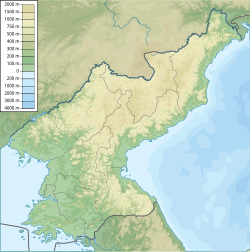The Sinuiju Formation(신의주층) is a geologic formation in North Korea. Formerly of uncertain age, it is now thought to be Early Cretaceous. A variety of fossils are known from the formation, including those of anurognathid pterosaurs (possibly Jeholopterus) and birds such as the specimen of a very large enantiornithine with a 5 cm (2.0 in) long tibia and a 3.5 cm (1.4 in) long pygostyle. Frogs have also been found in the formation.[1][2] Numerous compression fossils of insects have also been found.[3]
| Sinuiju Formation | |
|---|---|
| Stratigraphic range: Barremian-Aptian | |
| Type | Geological formation |
| Sub-units | 8 members |
| Overlies | Precambrian basement |
| Thickness | >500 metres (1,600 ft) |
| Lithology | |
| Primary | Sandstone, siltstone, mudstone |
| Other | Andesite |
| Location | |
| Coordinates | 40°06′N 124°24′E / 40.1°N 124.4°E |
| Approximate paleocoordinates | 43°48′N 125°48′E / 43.8°N 125.8°E |
| Country | |
| Type section | |
| Named for | Sinuiju city |
Fossil content
editFish
Amphibians
- Anuran (a frog, might be referred to Liaobatrachus grabaui).[4]
Pterosaurs
- Jeholopterus cf. ningchengensis[1][2][5]
Birds
- Confuciusornithidae indet. (Includes the fossil known colloquially as the Archaeopteryx of Korea)[1][2]
- Enantiornithes indet.[1][2]
- Ornithurae indet.[2]
Dinosaurs
Dinosauria indet (tooth)[6]
Mammals
Multituberculata indet.[7]
Insects[8]
- Angarosphex baektoensus
- Ephemeropsis sp.
- Karataus ryonsangensis
- Pompilopterus ryonsangensis
- Sinuijuhelorus baektoensis
- Sinuijus baektoensis
- Stellularis sinuijuensis
- Stenophlebia ryonsangensis[9]
- Sinuijumantispa ryonsangiensis[10]
Other invertebrates
- Eosestheria (a conchostracan)[2]
See also
editReferences
edit- ^ a b c d e f Gao, K.; Li, Q.; Wei, M.; Pak, H.; Pak, I. (2009). "Early Cretaceous birds and pterosaurs from the Sinuiju Series, and geographic extension of the Jehol Biota into the Korean Peninsula" (PDF). Journal of the Paleontological Society of Korea. 25 (1): 57–61. ISSN 1225-0929.
- ^ a b c d e f g h Choi, S.; Lee, Y.N. (2017). "A review of vertebrate body fossils from the Korean Peninsula and perspectives". Geosciences Journal. 21 (6): 867–889. Bibcode:2017GescJ..21..867C. doi:10.1007/s12303-017-0040-6. S2CID 133835817.
- ^ Jon, SuHyang; Won, CholGuk; So, KwangSik; Nam, TuYong (July 2019). "New Mesozoic insect fossils from the Democratic People's Republic of Korea". Cretaceous Research. 99: 240–245. Bibcode:2019CrRes..99..240J. doi:10.1016/j.cretres.2019.02.019. S2CID 134337948.
- ^ So, Kwang-Sik; Jong, Tal-Mi; Won, Chol Guk; Jo, Song-Dae (2022-08-05). "A fossil anuran from the Lower Cretaceous Sinuiju Formation, North Phyongan Province, Democratic People's Republic of Korea". Cretaceous Research. 140: 105304. Bibcode:2022CrRes.14005304S. doi:10.1016/j.cretres.2022.105304. ISSN 0195-6671. S2CID 251425462.
- ^ So, K. S.; Kim, P. H.; Won, C. G. (2024). "First Articulated Rhamphorhynchoid Pterosaur from the Early Cretaceous of the Democratic People's Republic of Korea". Paleontological Journal. 57 (1 supplement): S90–S94. doi:10.1134/S003103012360018X.
- ^ Won, Chol Guk; So, Kwang-Sik; Pak, Un Song; Ju, Il Yop; Ri, Chol Jun; Jon, Su Hyang; Ma, Jun (November 2022). "Discovery of Early Cretaceous Sinuiju Biota in the Democratic People's Republic of Korea and comparison with Jehol Biota in China". Cretaceous Research. 139: 105303. Bibcode:2022CrRes.13905303W. doi:10.1016/j.cretres.2022.105303.
- ^ Won, C. G.; So, K. S.; Jon, S. H. (December 2023). "The First Known Mesozoic Mammal in the Democratic People's Republic of Korea". Paleontological Journal. 57 (7): 826–832. Bibcode:2023PalJ...57..826W. doi:10.1134/S0031030123070122. ISSN 0031-0301.
- ^ Paektodong, Sinuiju City at Fossilworks.org
- ^ Won et al., 2021
- ^ So, Kwang- Sik; Won, Chol-Guk (2022-02-16). "A new fossil mantis fly (Insecta: Neuroptera: Mantispidae) from the Lower Cretaceous of the Democratic People's Republic of Korea". Cretaceous Research. 135: 105175. Bibcode:2022CrRes.13505175S. doi:10.1016/j.cretres.2022.105175. ISSN 0195-6671. S2CID 246936524.
Bibliography
edit- Won, C.G.; So, K.S.; Kim, H.C. (2022), "A new odonatan (Stenophlebiidae) from the Lower Cretaceous Sinuiju Formation of North Phyongan Province, the Democratic People's Republic of Korea", Palaeoworld, 31: 116–120, doi:10.1016/j.palwor.2021.02.002
